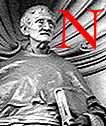[To demonstrate that "Shakespeare has gone out; Planche has come in" (210), Dallas devotes most of his article to a detailed description not of the "serious" theatre in contemporary London but of the pantomimes, burlesques and spectacles particularly popular around the winter holiday season. But there is also a more theoretical section, discussing "the present state of the drama" (219) in relation to the other arts, part of which is extracted here. - Graham Law]
The Drama

ow, if some of the phrases which we have been using, have been used correctly; if we have been right in speaking of the pre-Raphaelitism and realism of the theatre, it will be evident that the question as to the present state of the drama, in particular, resolves itself into a much wider question as to the present state of art generally. And the fact is, that the more narrowly we examine the sister arts, the more nearly do we find that they assimilate. In the pictorial art we find the same symptoms of disintegration and decay as in the dramatic; in both, we find the same elements of promise. Look at the walls of our exhibition-rooms, and behold the inanities that figure there, contemporary with the inanities of the theatre. This picture either displays as little action as a modern tragedy, or its action is as spasmodic as an Adelphi melodrama. In how many of these pictures do we find the artists compensating for bad drawing with gaudy colour, hiding vacancy of expression in a blaze of light, feebleness of passion in a tornado of shadows, and blundering perspective, aerial and linear, in a mist as convenient as the clouds by which the gods of Homer saved their heroes from the lances of the enemy? The very faults we find in the theatre! Eternal mannerism, staginess, mimicry, trickery, grimacing, catchwords, red lights and blue lights, and the name of the perruquier mentioned in the playbills in large letters! . . . Whether on the boards or on the canvass, incapacity and commonplace issue in virtually the same results. And it so happens that if one were asked what are the most striking, the most noteworthy, or the most notorious peculiarities, at this moment, of our picture-galleries on the one hand, or of the theatres on the other, one must inevitably fix upon the pre-Raphaelitism of the one, and the Revivalism of the other, and recognise them as twins. Only it must be remembered that the pre-Raphaelitism of the picture-galleries is but one of the forms, although the most peculiar form, in which the tendency to realism is manifested. It is manifested not less determinately in the prominence given to portraiture — portraits of "men, women, and Herveys," portraits of dogs, portraits of horses, portraits of prize oxen and pigs, and dead game, and black-faced ewes. The colouring which Gibson gives to his statues is a move in the same direction. And the tendency is symbolised and strengthened by the photographic art which has sprung up within the last few years, and promises, whether for good or for evil, to exercise so much influence on every easel throughout the country.
To come to the point then: What is the meaning of all this realism? If, with all the multiform absurdities in which it is manifested, it must nevertheless be admitted that all or most of the symptoms of vitality in the imitative arts are at the present moment expressed in this manner, what is the value of it?
The fact is, that whenever this tendency to realism is manifested with more than ordinary force (we were going to say, virulence), it is a most critical symptom. It is distinctive of what the old physicians would have called two separate climacterics in the history of art. It marks the infancy and the old age of art — the rise and the fall. It is just as in the individual man — at first in childhood, and at last in second childhood, he worships the real, and refuses to accept what he cannot believe in as absolutely and historically true. "But is it true?" inquires the child; "is it a fact?" says the old man. The precise difference between the realism of infancy and that of age is another matter to which we shall afterwards have to refer: at present we have only to do with their generic identity. And as the individual man is in almost every respect a miniature of the race, so we find this generic realism characteristic of at once the beginning and the end of art. In the middle space it culminates towards the pure azure of the ideal. [219-21]
Links to Related Material
- Defining Pre-Raphaeite Realism
- On Theatre Scene-Painting — “one rarely ever sees a well-balanced scene in a Western theatre" (by Mortimer Menpes)
Bibliography
[Dallas, Eneas Sweetland]. "The Drama," Blackwood's Edinburgh Magazine 79 (February 1856): 209-31.
Created 2 February 2024